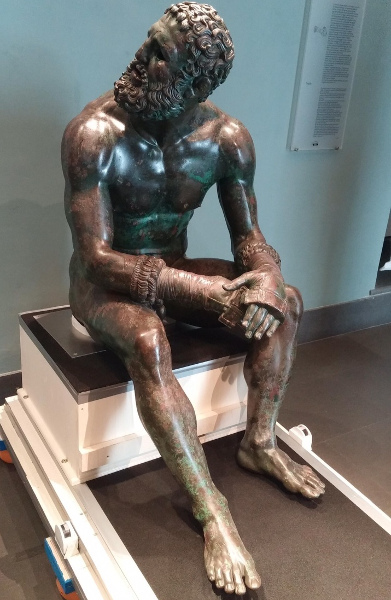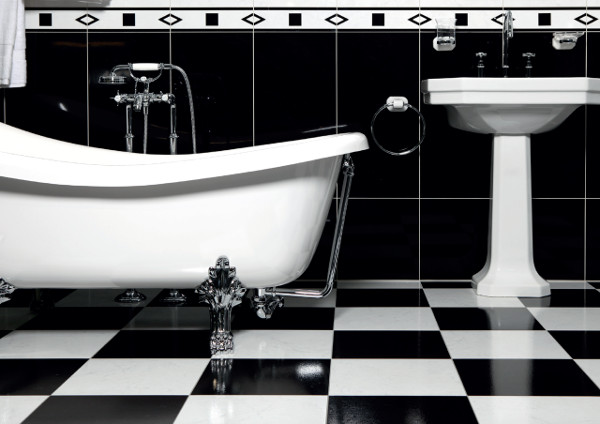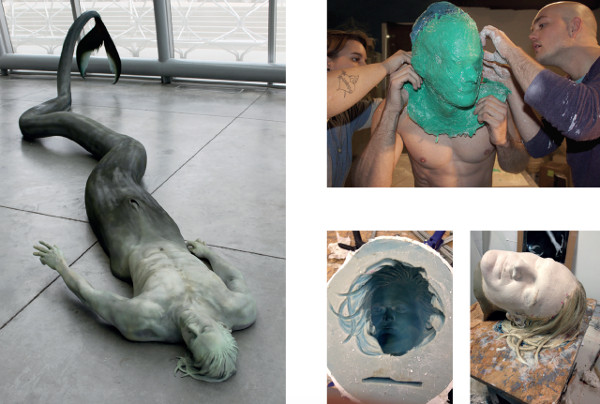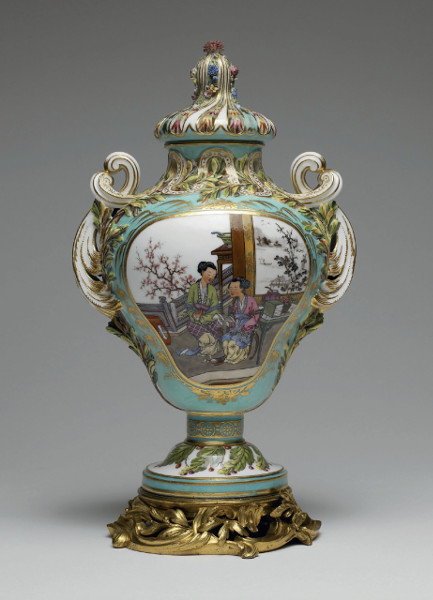The mission of this book is to re-establish an appreciation of the casting process, past and present, and they take the reader on a whirlwind tour of history and materials to do it.
By Margaret Lindsay Holton
Published August 18, 2017
This article has been updated.
Jen Townsend, Renee Zettle-Sterling, Cast: Art and Objects Made Using Humanity's Most Transformational Process, Schiffer Publishing
In my early twenties, while travelling in Central America, I wondered how people could produce such articulate and well-defined art. In particular, I became fascinated by the intricacy of the gold-cast frog jewellery, abundantly produced between the 8th and 16th centuries.
Later, in Europe, I stood before majestic human Greco-Roman bronzes and wondered again about the creative steps to achieve these masterful art works. How did they make these things?

How was this accomplished? (Bronze Cast)
Jen Townsend, MFA, and Renee Zettle-Sterling, MFA, both metalsmiths and jewellers, with the aid of another five experts, have provided a fascinating and insightful overview of the ancient transformational process of casting. With over 800 images to augment the easy-to-read text, I have finally found my answer, and then some.
At the onset, the authors offer a quiet lament: "Since the industrial revolution, casting's reputation has been in decline, and unfortunately, it's now associated with cheap, mass-produced knock-offs."
Once an honoured and revered process managed by skilled artisans, craftsmen and apprentices, casting of one or multiple objects has slid into the mediocre. The mission of this book is to re-establish an appreciation of the casting process, past and present.
The authors take us on a whirlwind tour of history and materials, model sculpting and mold-making, with the final note given to the mysterious alchemy of heat to transform liquid.
Amply illustrated with fine reproductions of ancient works and contemporized by excursions into modern practitioner's studios, readers are offered a somewhat dizzying array of past accomplishments and introduced to provocative examples of contemporary use.
Casting has been practised throughout the world for over 6000 years. The Chinese were the first to excel at the process. The famous tomb of the Terracota army of the Qin Dynasty, (221-206 BCE), contains over 8,000 cast soldiers, 130 chariots and 670 horses.
Knowledge of casting methods travelled west, where artists of the Greco-Roman empires soon utilized the hot wax process to immortalize their leaders and embellish their empires with majestic and symbolic public art.
The Renaissance exploded with bold new works. During the Enlightenment, the process of casting moved increasingly toward servicing the domestic with the development of porcelain factories. Casting has come full circle, returning to Asia, where cheaply mass-produced cast-plastic items now flood global markets.
Casting has, in many ways, defined the emergence of the middle class.
We are too quick to dismiss the impact casting has had on the quality of our lives. Look around you. From the rings on your fingers to the computer or smartphone in front of you, from kitchenware to the cars parked outside, casting has been an integral part of humanity's development for centuries.

Consider how many objects were cast for this bathroom (2011) (Image Credit: Schiffer Publishing)
It all starts with a model. This can be made from a wide range of materials, with the commonly used being clay, plasticine or plaster. The desired form is primarily shaped by a talented hand with shaping tools. Careful preparation ensures the elimination of unwanted ridges or imperfections. All is done to create the desired clean cast.
A mold is then made of the model. The variations of molds are vast. From commonly used flat back molds (like an ice tray or jello cup) to the intricacy of multipart silicone molds used in the automotive industry, mold-makers have to think about forms in the round. They have to think of negative space. They have to carefully consider how the intended liquid medium - be it glass, bronze, plastic or gold - will flow into the mold.

Cameron Stalheim's casting process, circa 2014 (Image Credit: Schiffer Publishing)
Intrinsic to this process is a deep understanding of the furnace or kiln. Here, precision must couple with patience. Many a mold, and casting, is easily wrecked by an inadequate understanding of what heat can do.
Once the cast has cooled, the casting is removed from the mold (not much explanation is given how that is done).
Then the process begins to finish the object. Finishing can involve multiple processes, including sanding, grinding, polishing and/or painting and assembly. All finishing efforts aim towards the desired final look of the object. When working with metal, like iron or bronze, this is often referred to as the patina.

Sevres Porcelain Manufacturing (1762) Overall Height: 11.75". Materials: Soft porcelain paste, enamel and gilding. (Image Credit: Schiffer Publishing)
Casted objects are such an integral part of our lives now, it's difficult to imagine how we would have evolved without it. From he mundane to the monumental, from soda pop bottles to the ethereal perfection of René Jules Lalique's art object, we would all be much the poorer without the process.
And yes, as much as we are increasingly overwhelmed by the pollution of cast plastic, combined global efforts are now underway to reduce, recycle and to re-purpose our combined consumer waste. This transition is happening.
Consider the Reef Ball Foundation, who create artificial reefs. Another organization, Eternal Reefs, incorporates the cremated remains of loved ones into artificial reefs. At time of writing, over 700,000 balls have been placed throughout the world's oceans.
Unlike cast soldiers buried in Emperor graves, or coins cast through millennia to pay debt, or plastic cups cavalierly tossed out car windows, these coral-dwelling balls are a potent reminder - and residual - of our own time and culture.
Cast your mind on that.
If interested to pursue further, ask your local library to order this inspiring and expensive book.
Update: updated to include higher-resolution images from the book, provided courtesy of Schiffer Publishing, and to correct an error: it is Eternal Reefs, not the Reef Ball Foundation, that incorporates cremains into artificial reefs. You can jump to the changed paragraph.
By Missy2013 (registered) - website | Posted August 18, 2017 at 15:04:44
p.s. Order the book here:
By kevinlove (registered) | Posted August 21, 2017 at 18:51:24
What would an article about casting be without a description of those largest of cast objects, bells? Here is a video showing the bells of St. Mary's at Oxford University. The largest bell, in the foreground weighs 2,977 lbs and was cast by Ellis I Knight in the year 1639. The four largest bells were all cast in the 17th century between the years 1612 and 1641. They are regularly rung for full-circle change ringing by members of The Oxford Society of Change Ringers.
Note how the band of ringers start out by ringing down the scale, what is called "rounds." The quality of striking is not quite perfect, but bell-ringing is one of the most difficult of musical arts. We can see a band ringing here, and an excellent video of someone learning to ring here. Note how I cleverly chose a video of an all-female band to try to counteract the stereotype that bell ringers are all large men.
It never ceases to amaze me how 17th century technology of rope and wheel enables an ordinary person of average strength to swing a two-ton bell in a full circle. And to do so with such control that the bell strikes at precisely the correct place in the pattern of ringing.
By Missy2013 (registered) - website | Posted August 22, 2017 at 12:10:32
Amazing! Thanks for sharing those links. What a mammoth job (in any era) to cast those beauts!
Interestingly, there are no bells in the book. Larger industrial-style projects, like airplane and ship hardware, are also missing.
Still, as reference and guide, the book is a very good introductory overview to the discipline, with ample illustrations.
By Missy2013 (registered) - website | Posted August 23, 2017 at 10:59:12
p.s. Stumbled on this blog that shows the interior of the Sevres Factory in France. May be of interest to some readers ...
By Missy2013 (registered) - website | Posted September 21, 2017 at 11:52:43
Anither interesting site, with exquisite pre-Colombian artefacts ~ https://www.howardnowes.com/images/newsl...
You must be logged in to comment.
There are no upcoming events right now.
Why not post one?